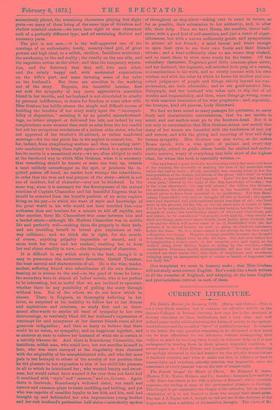The Fourth Gospel the Heart of Christ. By Edmund H.
Sears. (Boston, U.S. : Noyes, Holmes, and Co. London : Sampson Low and 00.) —Mr. Sears has taken as his title a phrase of Ernesti's which certainly expresses the feeling of some of the profoundest thinkers in theology. This Gospel is pre-eminently the Gospel of the orthodox, but an earnest admiration of it is not limited to those who occupy their stand-point. The late J. J. Taylor felt it, though he did not see in the doctrine of the Logos more than a subtlety of Alexandrhui thought. The views of Mr. sears approach much nearer than this to the established Creed of 'Christendom, though they do not coincide with it. "Assuming that 'there are three Persons in the Godhead, or three sell-conscious Wills, is precisely the point where Trinitarianiam breaks up into Tritheism ;" --such is his language in an appendix, where the expression that -4‘ there are forms of Trinitarianism which drop the word 'persons,' and avoid this danger," indicates a preference for -what may be called Sabellianism. Still. Sabellian or not, Mr. Sears has given us in this volume a very able and thought- ful treatise, inspired throughout by a strong religious feeling, and -exhibiting at the same time cogent reasoning and an acute criticism. Preliminary chapters discuss "The Supernatural," "Miracles," and what Mr. Sears speaks of as "The Immanence of God in Man," or the influx from the Divine Personality into the conscioni3 nature of man. 'Then comes a chapter on Gnosticism, and then one on "The Johannean "Writings." Mr. Sears holds the common authorship of the Gospel and the Apocalypse, and argues with much force that the impugners of this belief have no idea "that there is any such condition of the human sfaculties as seers/up," a state which lifts a man out of himself, and in -which we expect him to be, and indeed he must be, different from him- 'sell. Besides this, he shows with much clearness that there are under this difference very striking identities of thought; for instance, the central figure of the Apocalypse, "The Logos of God," who goes forth to war with the armies of heaven following Him, is the Person of whom the Evangelist undertakes to write. The argnment from early testi- mony to the authorship of the Gospel is then stated. The narrative is 'then examined in detail, 'and a concluding chapter deals with the -"Johannean Theology." We must quote a passage from the " Re- -appearings of Jesus," and with this commend the volume very heartily to our readers. The writer has been speaking of the external testi- mony to the fact of the Resurrection, and he continues :—
"There is evidence of another kind. It is the common. consciousness of the first Christian Church and the first Christian age of the new 'Power moving upon human nature and rapidly transforming it, as the risen Christ, both in his truth and his spirit, was melting through its depravities and errors. It will not do to ascribe this consciousness to fanatical imagination, and allow it no objective reality. Neither fanatical imaginations nor epileptic swoons change men from the dominion of lust, hatred, deceit, and demoniacal passion, to that of love, purity, meekness, and the peace of God; and from narrow and selfish ends to the most heroic self-sacrifice and the highest moral energy the world had ever known. Dreams and visions which are generat3d of morbid conditions, and are only subjective, never bring new clearness and vigour to the wasted faculties, never evolve a more perfect manhood from under the old decay. But all this was done, and it was done with the common consciousness that the risen and glorified Christ was in its work as its inspiring life, and .again and again was this corroborated by a parting of the clouds, between which he appeared to them from his nearing heavens to guide them. The inauguration of a new era of history in connection with this common consciousness is the complete confirmatory evidence of the resurrection of Jesus Christ."



































 Previous page
Previous page